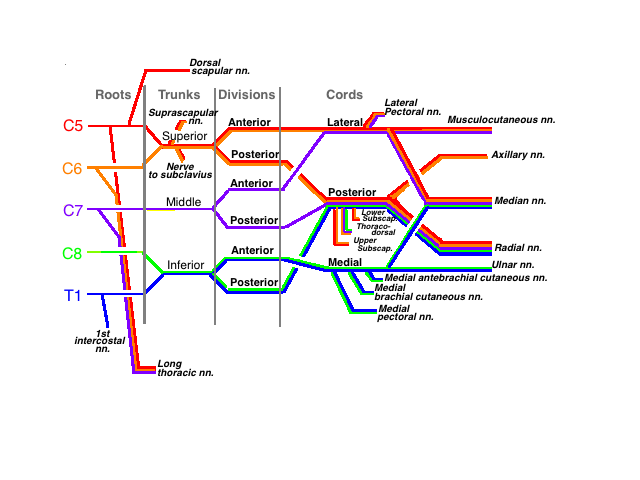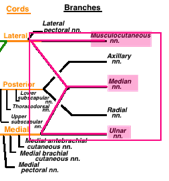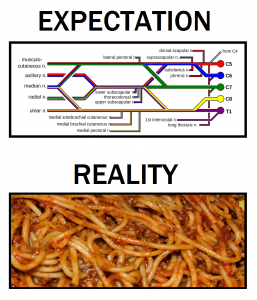The brachial plexus = a beast to learn.
Whether you are learning the brachial plexus for the first time or you just need a refreshing take on the basic structure, these are tricks I used to study the brachial plexus’ sections and terminal branches.
My first experience with the brachial plexus was in the cadaver lab, and I distinctly remember being absolutely lost in what seemed to be a web of nerves and deception.
I could hardly determine nerve tissue from fat tissue, let alone know that it was broken down into different sections that all led down a pathway to terminal nerve branches.
Like I said…this thing was a web of deception as far as I was concerned. I knew absolutely nothing about the brachial plexus other than the fact that it started somewhere in the neck and somehow made its way into the armpit (or axilla for those who prefer anatomical terms).
Do yourself a favor, especially if you are a new student, and figure out the basics of the brachial plexus before you go into the cadaver lab.
Brachial plexus got you confused? Draw it out!

Once you get the basic structure of the brachial plexus down, it should be easier to recall the routes of the nerves and what they go on to innervate. Save yourself the headache of pure memorization and draw it out. This will also allow you to have a road map you can follow at any time you need a reference. This can be especially handy during an exam or lab practical.
5 Roots
This is the easy part, the beginning. There are five nerve roots that supply the brachial plexus. More specifically, it is the ventral rami of C5, C6, C7, C8, and T1 which are essentially the bases of the structure. Unfortunately, I do not have a trick for remembering the specific roots, this part really is just memorization.
This section has multiple branches directly off of the roots. These branches are the dorsal scapular nerve that branches off of the C5 nerve root, the long thoracic nerve that branches from roots C5, C6, C7, and the first intercostal nerve that branches off of the T1 root.
3 Trunks
In the neck, the roots will come together to form trunks. The nerve roots of C5 and C6 form the superior trunk, C7 continues on to become the middle trunk, and the roots of C8 and T1 come together to become the inferior trunk.
The trunks are simply named by their anatomical position, so the top trunk is the superior trunk, the bottom trunk is the inferior trunk, and the middle trunk is in between the superior and inferior trunks.
The trunks are formed before the brachial plexus passes behind and below the clavicle. There are two notable branches in this region, the suprascapular nerve and nerve to subclavius which branch off of the superior trunk.
6 Divisions
The six divisions are very simple because each trunk splits into an anterior and posterior division. The anterior divisions will supply the anterior compartment of the upper extremity, and the posterior divisions will supply the posterior compartment of the upper extremity.
When I draw it out, I split each trunk into two, and I label the top lines of each division anterior and the bottom lines of each division posterior. If this is confusing, refer to the picture above to see how I split and label these divisions.
3 Cords
The cords are named by their relation to the brachial artery. When drawing this out, it helps to start with the anterior divisions. The anterior divisions of the superior and middle trunks join to become the lateral cord, which is lateral to the brachial artery. The anterior division of the inferior trunk continues on to become the medial cord which is medial to the brachial artery. Finally, all of the posterior divisions join and become the posterior cord which is indeed posterior to the brachial artery. This can seem like a lot of moving pieces, so this is where having the drawing as a reference can be very beneficial. Each of these cords has terminal nerve branches that innervate the remaining muscles and sensation of the upper extremity.
3 Branches from the lateral cord
The lateral cord has three branches. A mnemonic that may help to remember these branches is “Let Me Lift.”
The nerves are the Lateral pectoral, the Musculocutaneous, and the Lateral contribution to the median nerve. I like to envision Arnold Schwarzenegger saying “let me lift” as he flexes his biceps and pecs.
In reality, Arnold would probably say something along the lines of “Brachial plexus? More like Brachial FLEXus.”
Picturing the biceps and pecs flexing can be useful because they are some of the specific muscles the musculocutaneous and lateral pectoral nerves innervate.
5 Branches from the medial cord
The medial cord has five branches. Four out of five of these branches have “medial” in their name, but that does not help with remembering the actual names of the branches.
The nerves that branch in this region are the Medial pectoral, Medial brachial cutaneous, Medial antebrachial cutaneous, Medial contribution to the median nerve, and the Ulnar nerve. That gives me a medial headache…
Using an uppercut as a reference may be a bit of a stretch, but if it helps why not use it? I like to use uppercut because in this move I picture the hand in a fist clenched which uses the flexor muscles of the forearm and hand. The median and ulnar nerves are responsible for innervating these flexors. The pecs are also used in stabilizing and generating a more powerful blow, which uses the medial pectoral nerve. The other two branches are cutaneous and which go to the skin. Cutaneous literally means “relating to or affecting the skin” and these will innervate skin of the medial arm and forearm.
5 Branches from the posterior cord
Finally, the posterior cord which is posterior to the brachial artery. It is also comprised of all of the posterior divisions and it innervates the muscles and skin of the posterior compartment of the upper extremity.
Using “ULTRA” as a reference, the specific branches are the Upper subscapular, Lower subscapular, Thoracodorsal, Radial, and Axillary nerves. The thoracodorsal nerve is also called the middle subscapular nerve because it branches in between the upper and lower subscapular nerves.
Bringing the brachial plexus together: the median nerve

When in lab or during an exam, a great landmark you can use to orient yourself is the median nerve. You should then be able to identify the cords and branches based off of their relationship to the median nerve. As you can see in this picture, the medial and lateral contributions to the median nerve will join together to make the inside of the “M” (the median nerve). The outside structure of the “M” is formed by the musculocutaneous and ulnar nerves, which are terminal branches of the lateral and medial cords respectively, as mentioned earlier.
Relationships in anatomy are key. Understanding the different relationships, not only in the brachial plexus, but in the entire body, can save you a lot of time. By now you know there are many sections and anatomical terms that make up the brachial plexus. This method of mnemonics and drawing it out requires less pure memorization and more understanding of relationships which can aid in easier recall for future reference.
References:
Moore, K.L., Dalley, A.F., & Agur A.M. (2014). Clinically oriented anatomy. Philadelphia: Wolters Kluwer Health/Lippincott Williams & Wilkins.

